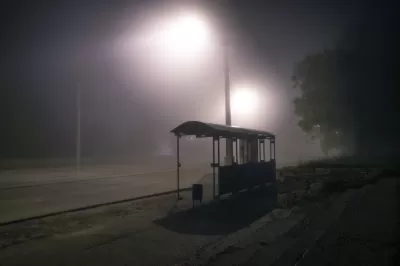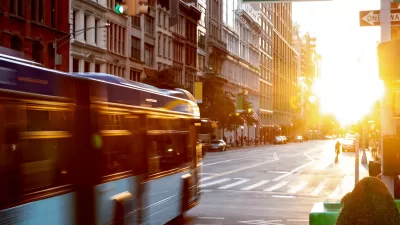Operator shortages are causing transit agencies to cut service unpredictably, leaving riders waiting for ‘ghost buses.’

A blog post from Transit Center explains the phenomenon of “ghost buses,” buses that appear on smartphone apps as minutes away only to never materialize at the station.
“What’s behind this alarming rise in ghost buses? Amid a national shortfall of transit operators, years in the making and worsened by the pandemic, there simply aren’t enough bus operators to run all the trips that transit agencies schedule.” In Los Angeles, the county’s transit agency canceled 1 in 6 trips in January of this year due to a shortage of 600 operators.
There are technical challenges to tracking ghost buses, for riders and agencies alike. Transponders aboard en-route buses share their locations via GPS, feeding real-time arrival boards and trip-planning apps. Canceled trips don’t generate GPS locations, so apps reference and display scheduled arrival data instead. This misleads riders into thinking their bus is running when it’s not.
The blog post recommends that transit agencies begin by tracking and publishing canceled buses to provide more transparency and identify solutions. “Agencies also need to be realistic about the amount of service they can provide with the labor force they have, and adjust schedules accordingly.”
The root of the problem, the blog post cautions, is the structural problems leading to the operator shortage. Transit agencies “must radically improve the job for operators by raising pay and improving working conditions. They must also attract new operators by offering signing bonuses and addressing roadblocks to starting the job, like long waits to receive commercial drivers’ licenses and unnecessarily strict drug testing.”
FULL STORY: Ghost Buses are Haunting Riders Across America

Maui's Vacation Rental Debate Turns Ugly
Verbal attacks, misinformation campaigns and fistfights plague a high-stakes debate to convert thousands of vacation rentals into long-term housing.

Planetizen Federal Action Tracker
A weekly monitor of how Trump’s orders and actions are impacting planners and planning in America.

In Urban Planning, AI Prompting Could be the New Design Thinking
Creativity has long been key to great urban design. What if we see AI as our new creative partner?

King County Supportive Housing Program Offers Hope for Unhoused Residents
The county is taking a ‘Housing First’ approach that prioritizes getting people into housing, then offering wraparound supportive services.

Researchers Use AI to Get Clearer Picture of US Housing
Analysts are using artificial intelligence to supercharge their research by allowing them to comb through data faster. Though these AI tools can be error prone, they save time and housing researchers are optimistic about the future.

Making Shared Micromobility More Inclusive
Cities and shared mobility system operators can do more to include people with disabilities in planning and operations, per a new report.
Urban Design for Planners 1: Software Tools
This six-course series explores essential urban design concepts using open source software and equips planners with the tools they need to participate fully in the urban design process.
Planning for Universal Design
Learn the tools for implementing Universal Design in planning regulations.
planning NEXT
Appalachian Highlands Housing Partners
Mpact (founded as Rail~Volution)
City of Camden Redevelopment Agency
City of Astoria
City of Portland
City of Laramie





























